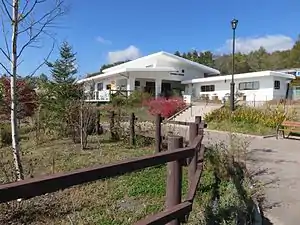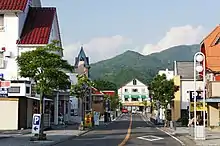Kiyosato Station
Kiyosato Station (清里駅, Kiyosato-eki) is a railway station in Kiyosato in the city of Hokuto, Yamanashi Prefecture, Japan. Kiyosato Station serves as the gateway to the surrounding highland resort area as well as the Kiyosato Educational Experiment Program (KEEP), a Summer camp, agricultural training and conference center established in 1938 by American missionary Paul Rusch. With an elevation of 1,274 m (4,180 ft) on the southern slopes of Mount Yatsugatake, Kiyosato Station is the second highest station on the JR East rail network and the station with the highest elevation in Yamanashi Prefecture.
Kiyosato Station 清里駅駅 | |||||||||||
|---|---|---|---|---|---|---|---|---|---|---|---|
 Kiyosato Station in October, 2014 | |||||||||||
| Location | 3545 Kiyosato, Takane-cho, Hokuto-shi, Yamanashi-ken 407-0301 Japan | ||||||||||
| Coordinates | 35°55′09″N 138°26′12″E | ||||||||||
| Elevation | 1,275 meters | ||||||||||
| Operated by | |||||||||||
| Line(s) | ■ Koumi Line | ||||||||||
| Distance | 17.5 km from Kobuchizawa | ||||||||||
| Platforms | 2 side platforms | ||||||||||
| Other information | |||||||||||
| Website | Official website | ||||||||||
| History | |||||||||||
| Opened | 29 July 1933 | ||||||||||
| Passengers | |||||||||||
| FY2015 | 219 daily | ||||||||||
| Services | |||||||||||
| |||||||||||
| Location | |||||||||||
 Kiyosato Station Location within Yamanashi Prefecture  Kiyosato Station Kiyosato Station (Japan) | |||||||||||

Lines
Kiyosato Station is served by the Koumi Line and is 17.5 kilometers from the terminus of the line at Kobuchizawa Station.
Station layout
The station consists of two ground-level opposed side platforms, connected by a level crossing. The station has a Midori no Madoguchi staffed ticket office.
History
Kiyosato Station was opened on 27 July 1933 by the Japanese Government Railways. With the privatization of Japanese National Railways (JNR) on 1 April 1987, the station came under the control of JR East.
Passenger statistics
In fiscal 2015, the station was used by an average of 219 passengers daily (boarding passengers only).[1]
Surrounding area
- Kiyosato Modern Art Museum
- Japan National Route 141
See also
References
- 各駅の乗車人員 (2015年度) [Station passenger figures (Fiscal 2015)] (in Japanese). Japan: East Japan Railway Company. 2016. Retrieved 5 July 2016.